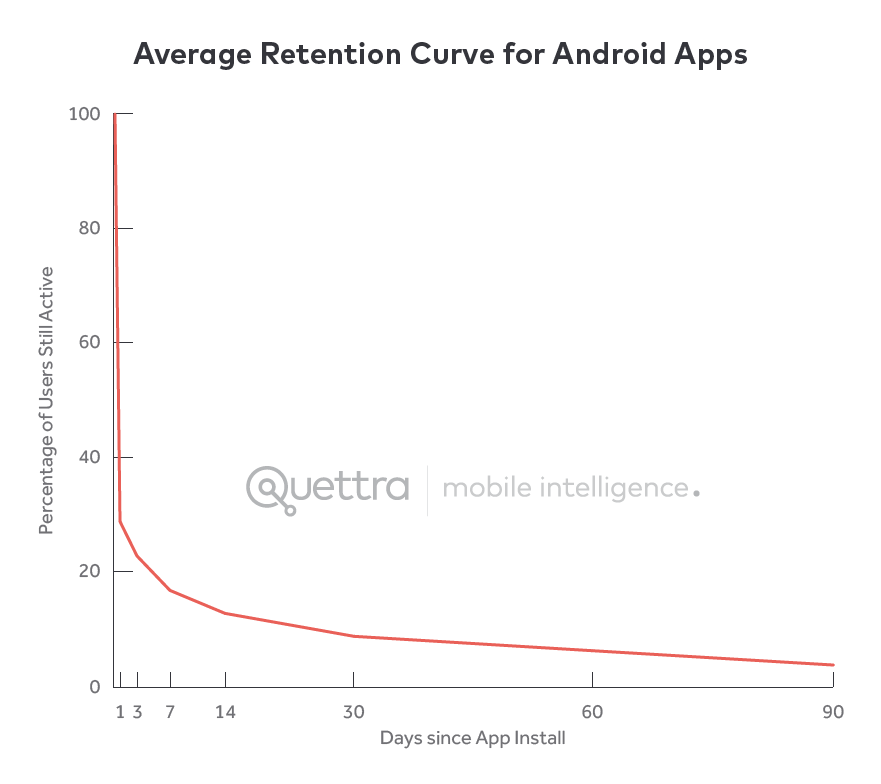The app market is flooded with apps. There are multiple options for a specific use case. For instance, both PlayStore and App Store have plenty of gaming apps and digital payment apps. In the light of this fierce and ever-growing competition in the app market, you must deliver a flawless user experience (UX) to your target crowd. Users should enjoy a glitch-free and smooth experience while using your app. And how do you ensure a seamless user experience?
The answer is Quality Assurance.
According to Quettra, on average, apps lose over 95% of new users after 90 days.

The secret to retaining users is to get them hooked to your app by delivering your USP within the first 4-7 days. Since QA directly impacts the overall experience, mobile app companies that fail to do due diligence and thorough QA testing lose their users and market hold pretty quickly.
QA testing is a non-negotiable tenet throughout the software and mobile app development life cycle (SDLC). The SDLC is a structured and elaborate process that divides individual aspects of software development into different phases. If you wish to launch top-notch applications with flawless UX, you must incorporate QA testing into each stage of the SDLC.
What is the purpose of QA testing?
Quality Assurance (QA) focuses on preventing and eliminating all possible errors during the software development process. In essence, QA determines the standard methodologies and procedures to be followed during the SDLC to cater to the target user base’s requirements.
Although the primary goal of QA testing is to identify and fix errors to enhance software quality throughout all stages of production, the three core goals of QA testing are:
- Demonstration: It demonstrates which functions can be integrated within the system (under specific conditions) with acceptable risk.
- Detection: It aims to identify bugs and errors to determine the abilities and limitations of the system, its components, and the final product.
- Prevention: QA helps reduce the incidence of errors, clarify system specifications, and monitor system performance.
QA outlines the possible ways to prevent failures/issues in the future. Thus, by integrating QA testing into all SDLC stages, you can improve internal development practices and minimize errors to enhance the final product quality.
The role of QA in the six stages of the Software Development Life Cycle
The software development life cycle has six stages – planning, design, implementation, testing, deployment, and maintenance – and QA testing plays a vital role in each.
1. Planning
The planning phase is the first step where developers and stakeholders decide on the product’s features. While many may think, “what’s the role of QA in the planning phase?” having QA Testers and Analysts on board during the planning process can bring one of the most crucial elements – UX. QA experts know which features are a hit or miss with the target audience. Hence, they can help craft the best-suited features to cater to the user requirements/ preferences, saving both money and time that would have otherwise been wasted on developing irrelevant features.
2. Design
Design holds a pivotal place in the overall user experience. Users love design features that are neat, straightforward, and deliver value to them. While some designs may be visually appealing, they may not be functional. When QA experts are involved early on in the design phase, they can highlight problematic or efficient aspects of design samples. As this follows an improve-as-you-go approach, developers can craft the optimal design in collaboration with QA testers.
3. Implementation
Typically, there are numerous ways to implement new features during the SDLC. However, each attribute and method has its unique pros and cons. Let’s assume, a developer is considering to opt a technique for implementing a data-intensive part of a webpage. While this method ensures a visually-appealing result, it would take longer to load. Pages that take longer to load don’t make for a good user experience. This is where a QA expert’s opinion could make a real difference. They could help weigh in on the optimal loading time, best animation features, navigation features, etc.
4. Testing
The role of QA becomes critical during the testing phase. Testers mainly focus on implementing the best QA practices while writing test cases, bug reports, tracking updates, checking device-browser compatibility, and much more. They must pay attention to minute details in every aspect of the development process and implement QA tactics to improve the outcomes.
5. Deployment
QA Testers/Analysts in a mobile app development company must always be on standby in a call during the actual deployment process. Once the release and app go live, QA experts together with Software Developers perform smoke testing, unit testing, functional testing, user acceptance testing, and regression testing to check if the deployment triggered any issues. Then they proceed to report, categorize and fix bugs.
6. Maintenance
The maintenance phase acts like another layer of quality check. Sometimes a few errors or bugs may slip through the testing and deployment stages. Developers and QA Testers perform another round of inspection and testing to identify and fix these bugs. Also, maintenance involves product upgrades to continually better the product to meet the evolving consumer tastes and needs.
Conclusion
To wrap it up, QA testing is an integral part of the SDLC. It is one of the most crucial determinants of an app’s success or failure in the market. QA testing not only helps save time, effort, and money, but it also ensures that each time you deliver a competitive and best-in-class product to your customers. Not just that, QA testing ensures that your apps adhere to data security and compliance standards.
The bottom line is – QA testing can help you maintain a good reputation and strong foothold in the industry. So, don’t underestimate the potential of QA testing!




